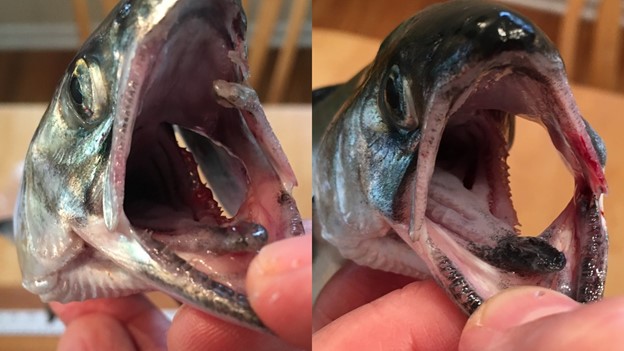April offers some fantastic fishing for salmon and trout. Pier, small boat, and surf fishing can be especially productive at this time of year since the shallows warm more quickly than offshore waters. Brown trout are a popular target at many northern and central Lake Michigan ports, while coho salmon are a big draw farther south. On Lake Huron, Atlantic salmon are becoming a popular target following the expansion of stocking efforts in recent years.
Anglers on both lakes have been contributing to community science efforts including the Huron-Michigan Predator Diet Study and Great Lakes Angler Diary. For both of these projects, it is very important to correctly identify what species of fish you have caught. Spring fishing offers special challenges since brown trout are easily confused with Atlantic salmon, and small Age 1 Chinook salmon can be mistaken for cohos.
Mini-king or coho?
The coloration of gums and spotting pattern on the caudal (tail) fin are often used to distinguish adult Chinook salmon (kings) from coho salmon. In adults, the gums of the lower jaw are typically black in Chinook salmon and white in coho salmon. However, very small Age 1 Chinook salmon may exhibit a lighter coloration in the lower jaw and could be mistaken for cohos (see photos).

To add to the confusion, tail spotting is not fully developed in small salmon. Adult Chinook salmon have spotting on both lobes of the caudal fin, while coho salmon typically have spots only on the upper lobe (although spotting on both lobes is sometimes seen in coho, as well). Small Age 1 Chinook salmon have deeply forked, unspotted tails that gradually develop into square, spotted tails as they grow (see photos).
Fortunately, the shape of the anal fin remains consistent throughout a Chinook salmon’s life in the big lake. Even small Age 1 Chinook salmon exhibit an elongated anal fin with a short first ray (less than 2/3 of the length of the base of the anal fin). This separates them from coho salmon and all other Great Lakes salmon and trout, making it an important characteristic to use when identifying salmonines.
Brown or Atlantic?
Both brown trout and Atlantic salmon display quite a bit of variation in coloration and spotting, making it difficult for anglers to ID their catch. The length of the maxilla (upper jaw bone) is a good characteristic to use in spring. Like largemouth bass, the maxilla of a brown trout extends beyond the eye. This is not usually the case for Atlantic salmon, but the jaws of male Atlantic salmon change shape as they mature and maxillas of spawning-phase male Atlantics can be confused with brown trout.
A more definitive characteristic for all seasons is the pattern of teeth in the middle of the roof of the mouth. Atlantic salmon have a single, straight row of poorly-developed vomerine teeth while brown trout have two staggered rows of vomerine teeth (see photo).
.jpg?language_id=1)
Michigan Sea Grant has a brochure and video that go into more detail on salmon and trout ID, along with a printable fact sheet for quick reference.
Michigan Sea Grant helps to foster economic growth and protect Michigan’s coastal, Great Lakes resources through education, research, and outreach. A collaborative effort of the University of Michigan and Michigan State University and its MSU Extension, Michigan Sea Grant is part of the NOAA-National Sea Grant network of 34 university-based programs.
This report was prepared by Michigan Sea Grant under award NA180AR4170102 from the National Oceanic and Atmospheric Administration, U.S. Department of Commerce through the Regents of the University of Michigan. The statements, findings, conclusions, and recommendations are those of the author(s) and do not necessarily reflect the views of the National Oceanic and Atmospheric Administration, the Department of Commerce, or the Regents of the University of Michigan.



